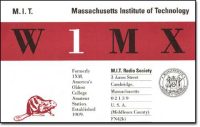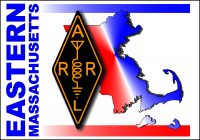 Milo Hooper, AI1XR, writes:
Milo Hooper, AI1XR, writes:
One hundred and eleven years after its founding, the MIT Radio Society is flourishing. Student interest in RF engineering, telecommunications, and radio science is growing. And, the pandemic notwithstanding, MITs amateur radio clubs right now are larger than they’ve been in decades.
Now that the “eleventy-first” (111th) year of the club is finally drawing to a close, we’d like to share some of the stories of the last 12 months, both of the challenges the club has faced, and how we’ve been able to continue to serve both MIT and the amateur radio community at large.
Green Building Renovation and the Future of the Station
The Radio Society faced a serious challenge this year. The enclosed station space and large radome located on the roof of the Green Building, the center of many of our activities, had been slated for removal due to a major renovation scheduled to begin this spring. Thanks to overwhelming support from our alumni and friends, MIT is now supporting much of the renovation of our physical space directly, enabling us to focus our resources not just on rebuilding, but on improving our VHF/UHF and microwave contest and research station, W1XM, on the Green Building roof for the MIT community. Our next step is working to preserve the iconic large radome and dish within. The radome and dish are central to our vision for the future of the station. You can read more here about that effort.
We recently circulated an open letter seeking support from the MIT community for saving the radomes, and in response MIT has begun a design study of options for restoration. See our website for the latest news.
Our vision for the station of the future
Our dream for the new station on the top of the Green Building is a space that provides expanded opportunities for students to explore not just amateur radio but the whole spectrum of intersecting fields, from experimenting with radio propagation and learning about the ionosphere, to radio astronomy, signal processing, microwave electronics, and more.
We envision a station with banks of SDRs and servers that students can access remotely and program for experiments; a station that has current state of the art amateur radio equipment for research, contests, general communication, and emergency operations; a space that lends itself to uses we may not yet anticipate, with room for new hardware and experiments students choose to create in future.
Our priority is to expand access to and use of W1XM to as many students as possible to maximize the value we provide the MIT community, both by enabling remote access to the station for its current uses, by providing an improved space on the roof itself for students doing all manner of radio related experiments, and eventually by partnering with other groups at MIT in supporting students exploring radio and communications technologies.
Radio Society Supports Remote Junior Lab Class
Most undergraduate teaching at MIT has moved online, including some lab courses. The MIT Radio Society has been able to help by making our 6m “Big Dish” available to physics students in Junior Lab, one of the most popular undergraduate Physics courses. Students are using the Big Dish for observational radio astronomy at 1.4 GHz (a hydrogen emission line). Check out a sample of the data that students have collected.
New HF Beam for W1MX
After two years of planning, W1MX primary HF beam antenna, a Mosley Pro-96 that has served the club for over 20 years, was replaced with a new antenna of the same model. In the near future, the original guy wire system will also be updated to ensure the tower remains stable and can continue to serve MIT’s amateur radio community for years to come. Plans are also in progress to install new equipment graciously donated by one of our alumni, L. Dennis Shapiro EE ‘55, SM ‘57, to enable remote operation of the station now that the new antenna has been installed.
Introducing Remote Ham Exams
The MIT Radio Exam Team is pleased to announce that it is now offering fully remote amateur radio license exams under the coordination of the W5YI-VEC. Not willing to let the pandemic stand in the way of getting new hams on the air, the amateur radio community came together to do what it does best: solve tough problems with ingenuity and technology. Since the MIT Radio Exam Team began offering remote exams, it has helped over 250 amateur radio operators obtain their first license or upgrade their existing one. Information about what it’s like to take a fully-remote ham exam with us can be found in our Remote Examinee Info Packet.

